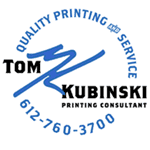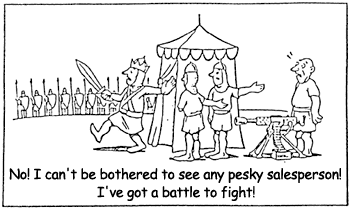

Tom Kubinski
Printing Consultant
tkubinski@sextonprinting.com
Direct: (651) 255-1225
Fax: (651) 457-7040
Cell: (612) 760-3700

 Mary Albers
Customer Service
mkc@sextonprinting.com
Direct: (651) 255-1255


 www.sextonprinting.com
250 East Lothenbach Ave.
Saint Paul, MN 55118
Phone: (651) 457-9255
Fax: (651) 457-7040
Toll Free: (800) 388-2914

Branding - 22 Laws Of
Brand Warfare
Creative Coatings Techniques
Desktop Techniques
Digital / Variable Printing
Direct Mail Raise Response, Lower Costs
Duotones-Tritones-Quadtones
FSC Certification
In House Mailing Capabilities
Ink Tour
Paper Mill Tour - Coated
Paper Mill Tour - Uncoated
Picking the Right Paper
PDF Formats
PDF Info & Quark vs. InDesign
Postal Increases & Requirement Changes
Post it to the Web vs. Print
Press Check Tips
Save Disk Space
Top File Issues
UV Burn
Ways to Save Money
What Sets Sexton Apart?
Why Work With TK?
|
 |
May 2006 TK's Korner
Ways to Save Money On Your Next Printing Project
Dan asks, "What can I do to save money?"
Before we start to discuss the many avenues that are availlable to you, we first need to discuss the bidding process. It is here that most of the money saving tips or costs will be incurred. Keep in mind, that the bidding process encourages people to cut corners and exclude things in order to bring down their prices in hopes of being awarded the project and then adding up charges or alterations to it once awarded.
Think back to just how many of
your projects actually came within budget? Do your up charges or alterations seem reasonable? If your billing is not coming within budget, the only upcharges you are recieving are from alterations you have made and they do not seem reasonable, you may start to realize substantial savings just by making sure a more detailed estimate is obtained up front.
The question is: "What is the goal that I am after within the bidding process? Is it simply to get a variety of bids that are apples to apples and make a decision based on that? Or, am I concerned about making sure that everyone really understands what the design is, how the piece is intended to be used and what the desired end results are?
 The latter of the two is what I aim to provide. With this consultative and partnership approach, I hope to ensure that everyone of your projects that we work on together is completely understood, the design intention is able to be accomplished/engineered and the bid is accurate. The only way to make sure that this is possible, is by asking questions up front. That way you will not encounter any surprises.
The latter of the two is what I aim to provide. With this consultative and partnership approach, I hope to ensure that everyone of your projects that we work on together is completely understood, the design intention is able to be accomplished/engineered and the bid is accurate. The only way to make sure that this is possible, is by asking questions up front. That way you will not encounter any surprises.
All of us know that in most cases not all of the specifications are decided. Yet, the more precise you are up front, the better your chances are that the bids are indeed apples to apples and you will not encounter
any surprises. This is especially important when you have creative that needs to be approved, budgets need to be approved, PO's have been cut etc.
Giving accurate, detailed information and a 100% to size color broken dummy will ensure that the bid you receive has been estimated correctly.
Listed below are items that are commonly given, overlooked and other options that you could look into if your design or end use allow. The overlookded items are typically where most of the up charges will be encountered.
Commonly Given:
- Name of piece
- Date and time estimate needed back
- Quantity
- Flat and finished folded size
- Stock weight, brand and finish
- Ink number of colors, if 4cp or not/PMS, does it bleed or not
- Coating or not and is it a varnish or Aqueous or which ever is cheaper
- Artwork in disk form and date to be ready
- Proofs needed Dylux, Epson or Matchprint
- Press check or not
- Seperations number and sizes of each
- Line Screen typically 175
- Die cut or perforate
- Embossing and if it registers to print or is blind
- Foil Stamping and if it registers to print or is blind
- Lamination if it is one sided or two, flush or sea
led edge and thickness
- Binding-saddle stitch, perfect bind, wire o, spiral, plastic coil, GBC etc.
- Mailing ink jetting, cheshire labeling and post office drop
- Delivery date and location
Overlooked Items:
- How does the piece fold -roll, letter, gate, accordian, double parallel etc
- If a roll fold, have the panels been adjusted for the fold
- Any critical cross over hook ups? If so, on what pages. Has the art been adjust for cross overs?
- Stock-comparable stock ok or not. Not all papers are created equally. Even a grade marked number one to another number one have differences. Domestic to Foreign ratings are also very diffferent. See issue entitled, Picking the Right Paper for more specifics. Note, if a family member piece going with a substitute could result in colors and images no
t matching.
- Ink-the colors of the PMS, any metalics and what colors. Plus the percentage of coverage for each
- If bleeds, where on the piece
- Does ink run across folds and is a score necessary. If scoring, will a press, folder or Letterpress score be ok
- Coatings-wet or dry trap, contaminated or clean. Are draw downs needed
- Artwork and the format or software working in. Some are not printing software friendly
- Proofs-are you familiar with our 3 different types, how each can be used and save money Dylux vs Epson vs Match Proof
- Press checks all forms or just one to set the color
- Seperations-match transparency or pleasing color. Are any rounds of color alterations to be included
- Die cutting-is die existing and can be furnished or new. Size of die. If perforating, is it on folds only or L shaped etc.
- Embossing-is die existing and can be furnished or new. Size of die. Is die single level, multi or sculptured. Blind or registering to print
- Foil stamping-is die existing and can be furnished or new. Size of die. Blind or registering to print. How handle Repeat Patterns
- Lamination-do you want a lay flat, satin, gloss or dull film, sealed or flush edge
- Binding-are you familiar with Ota
binding and its benefits/costs over perfect binding
- Mailing-how many lists will we be working with. Will we merge/purge and dupe eliminate? Who's indicia using? Is it going out first class, first class presort or presorted standard. Quantity of the printing that actually mails. Is this for a Non Profit?
- Is there a BRC and what is the size? To get automation postal discounts, you need to be at a 7pt or 9pt minimum. When over 4.25x6, must be 9pt minimum
- Grain Direction-sometimes the grain direction can really matter with various finishing processes and folding. Especially with your heavier weights. If this is not discussed up front, your bid could need to be adjusted in a positive or negative way.
Other Options:
- Bleed-going with no bleed sometimes may allow you to go to a smaller paper and/or press sheet size
- Size-down sizing the piece so it will fit onto a smaller paper and/or press sheet size. Also, this may allow you to still keep a bleed in some cases for no add'l cost
- Stock-ordering a specail sheet size to cut down on waste. Note, this usually takes time to get from the mills but can give you huge savings. If you only need a partial quantity, you may choose to put that small amount onto a standard sheet size to get done, while waiting on the balance for the special sheet size/savings
- Stock-going with a similar grade of a different brand name
- Scoring-going with a press or a folder score over a Letterpress score can save money. Note, the threat of cracking is only reduced by going with a LP score not elimnated
- Tint Stripping a PMS color can save money. Note, this can also cause you color consistantcy issues if heavy areas or a lot of process images are on piece. This should be discussed up front to see if it makes sense or not
- Proofs--Sexton has 3 different proofs available. Our Dylux is a CMYK backed up (not laminated together) and is ideal for projects that may have many eyes or possible changes. Epson proof is ideal for those projects that a CMYK dylux is not enough and where a pleasing color proof is needed. Ditgital Match Proof is for those color critical projects
- Press checking only a form or two versus all of the forms can save money.
- Coating-varnish, aqueous and UV will definately protect your piece in a variety of levels. Their costs sometimes will not follow the same suit though. Aqueous allows you to seal the sheet and move onto the
next step faster than a varnish which could nulify the cost savings of the coating itself. Note, finger printing is more apparent with UV over the other two and especially with darker background colors.
- Critical Cross Over Hook Ups can add to your project by requireing several extra procedures to be done. Typically your text weight stocks will require these extra steps while the cover stocks will not
- Foiling Repeat patterns--to avoid them within your run or live work, would require extra material to be purchased as well as a slower run speed to make sure non get mixed in
- Prepress-you can reduce production time by supplying a press optimized PDF file. Basically what this does, is reduce the amount of time necessary to prep and manage files. Best use would be for monthly publications, reruns, reruns with corrections etc. For more info. please contact me.
If you have a production issue not discussed above or a project that needs to be looked at, please give me a call or send me an e mail. You know I will do what it takes to ensure you get the best value for every marketing dollar invested.
Referrals are greatly appreciated. If you know someone who I should contact, please let me know.
If you would like to join me on one of our upcoming tours, if there is something that you would like me to address, or if you know of someone who might like to receive TK's Korner, please let me know via e-mail at tkubinski@sextonprinting.com or phone. Take care and have a great day.
Successfully,
 Tom Kubinski-Printing Consultant Tom Kubinski-Printing Consultant |




 The latter of the two is what I aim to provide. With this consultative and partnership approach, I hope to ensure that everyone of your projects that we work on together is completely understood, the design intention is able to be accomplished/engineered and the bid is accurate. The only way to make sure that this is possible, is by asking questions up front. That way you will not encounter any surprises.
The latter of the two is what I aim to provide. With this consultative and partnership approach, I hope to ensure that everyone of your projects that we work on together is completely understood, the design intention is able to be accomplished/engineered and the bid is accurate. The only way to make sure that this is possible, is by asking questions up front. That way you will not encounter any surprises.